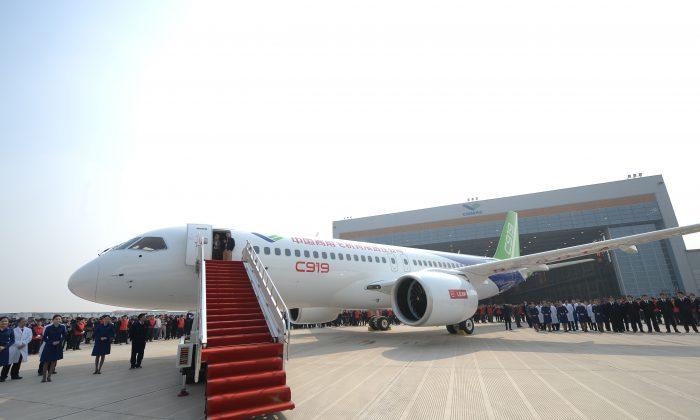This news analysis was originally dispatched as part of Epoch Times China email newsletters. Subscribe to the newsletters by filling your email in the “China D-brief” box under this article.
I’m routinely bewildered by foreign companies assisting Chinese companies to build products that are openly designed to replace their own markets in China. It seems Boeing and Airbus can now join the list.
The Chinese regime’s state-run Commercial Aircraft Group revealed China’s first domestically made large commercial aircraft on Monday. According to Business Insider, the event held at the airline factory in Shanghai was attended by close to 4,000 government officials and guests.
While China is currently one of the world’s largest markets for commercial aircraft, it buys its planes from Boeing and Airbus. With the new C919, it plans to change that. The single-aisle plane that can seat 168 passengers is designed to compete with the Airbus 320 and the Boeing 737.
While many of the C919’s critical parts come from outside the country, this could soon change. The Chinese Communist Party requires that the C919 favors parts produced in China.
Get ready for the irony. While the C919’s state-run manufacturer, Commercial Aircraft Corp of China (COMAC), has clearly stated it plans to replace the Airbus 320 and the Boeing 737, both Airbus and Boeing have been assisting the Chinese regime in this venture.
In September, Boeing signed a cooperative agreement with COMAC to set up a completion center in China for its 737 airliners. According to Crain’s Chicago Business, the “737 completion and delivery center will be the first facility of its kind outside the U.S. for Chicago-based Boeing.”
Airbus, meanwhile, was already a few steps ahead in assisting Chinese aerospace development. It already has an assembly line in Tianjin, China, for its 320 airliner.
Airbus also announced on July 2 that it will establish a Completion and Delivery Center in Tianjin, China, for its wide-body A330 aircraft, after signing a deal with Aviation Industry Corporation of China, and the Tianjin Free Trade Zone Investment Company.
And it should come as no surprise that, according to CNN, China’s COMAC said it plans to build a wide-body airliner next.
These plans have been a long time coming, and when Airbus and Boeing signed deals to build facilities in China, it’s likely both companies were aware that COMAC plans to replace their markets in China.
The RAND Corporation released a report on April 4, 2014, stating that COMAC was in the process of building the C919 narrow-body commercial jet, and that it would compete with similar aircraft from Airbus and Boeing.
According to RAND, COMAC was formed in 2008 when the Chinese regime consolidated its efforts under a new state-owned commercial aircraft manufacturing company, with the intentions to domestically produce two aircraft, the ARJ-21 regional jet, and the C919 narrow-bodied aircraft.
While COMAC has revealed its C919 airliner, it also has a few years to go before it can be built without foreign assistance.
CNN noted that most of its critical parts—including the landing system, tires, flight recorder, flight control systems, and many others—are still built by U.S. companies. The only critical parts on the C919 currently made in China are the wings, radar cover, fuselage, and tail.
This fits into the plan, however. The Chinese regime’s strategy, according to RAND, is “first engaging in domestic production and assembly using foreign designs,” the likes of which we’re already seeing with Airbus and Boeing starting factories in China.
After that, according to RAND, the Chinese regime plans to develop “its own designs with foreign assistance,” and this process will culminate in the Chinese regime building “a commercial aircraft without foreign assistance.”
In other words, Airbus and Boeing have willingly joined a process to help the Chinese regime build a commercial airliner, which eventually aims to learn from them until their presence in China is no longer needed.
It fits with the Chinese business philosophy of having a “Pei Lian” or “training partner.” It’s the idea that you work with someone until you learn their craft well enough to do it yourself.
That timeframe could also fit the planned rollout of the C919. It’s expected to fly next year, and enter service around 2019.
Behind the scenes, the Chinese regime is also hard at work learning to build various components for airliners. Much of this work has been done by acquiring foreign aerospace firms that already have the desired know-how.
I reported on some of these developments last year, when on May 19, 2014, Guangdong Elecpro Electric Appliance Holding announced it would purchase two European aerospace companies, the Swiss-based Mistral Engines SA and Germany’s SkyTrac.
It followed similar developments in 2013, when Aviation Industry Corporation of China acquired Germany’s Thielert Aircraft Engines, and in 2009 when it acquired Austria’s Fischer Advanced Composite Components.
It’s important to note that this isn’t just regular business. The Chinese Communist Party is driving the effort. According to a 2013 report from the U.K.’s Royal Aeronautical Society, “Aerospace has been targeted as a primary means of raising China’s overall economic performance through climbing ’the ladder of high-tech industrial economic value.'”





